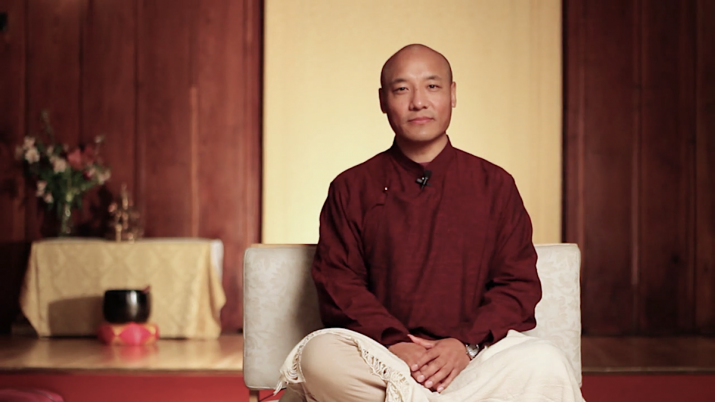
By the end of this century, a whole host of rare languages will have disappeared in the same way that endangered species are extinguished from face of the Earth. You might like to call this the extinction of language. Some ancient languages such as Latin and Sanskrit are still around, but they are considered dead because no existing societies use them in everyday life.
At one time, it was quite common for Indian Buddhist masters to compose sadhanas and philosophical texts in Sanskrit. However, many Buddhist Sanskrit texts have been lost forever in the midst of turbulent events, or because no one maintained them. Today, many texts exist in Tibetan and other Asian languages, indeed there is a huge body of Buddhist texts, originally translated from Sanskrit, that now exist only in the Tibetan language.
For the last few decades a number of individuals and institutions have been studiously translating numerous Tibetan texts into English. This work is almost a form of life insurance for these sacred scriptures. English is already the global lingua franca and will only continue to grow in usage and popularity. As long as these texts exist in English, there is always going to be someone who can understand them. One of the good things about this development is that almost all Tibetan words, including their subtle nuances, can be expressed in English. This is partly because English has a vast vocabulary and can convey both intuitive and technical concepts that some other languages might struggle with. Already, many Buddhist sanghas all over the world are chanting Buddhist liturgies and studying the texts in English.
Translating the sutras and shastras into Classical Tibetan took place as early as the eighth century. Trisong Detsen (r. c. 755–797), the 38th emperor of Tibet, sponsored this project at Samye Monastery, Tibet’s first gompa. He and various panditas also sanctioned standardized Dharma terms with the Madhyavyutpatti, two scrolls of standardized translation conventions that were used as reference texts. This helped to ensure the success of that ambitious and far-reaching project.
Today, however, there is no authority with the power to implement such a standard. Everyone is acting independently, with no form of collaboration that could help to unify the work of modern translators. This situation has both positive and negative implications, yet it is important to address the downsides because they are not being actively discussed in a public way. One of the most troubling issues is that particular texts can be overly influenced by the biases of a single person. In addition, a text can be translated by three translators in three different ways such that each version becomes localized without any authoritative version. Furthermore, individual translations of this kind can contain a lot of mistakes. There is a very real danger, therefore, that these problems could continue and eventually get out of hand.
A variety of sadhanas, prayers, poems, dohas, sutras, shastras, and tantras have been translated into English by well known translators, and by some not-so-well-known ones. We should be thankful for their work in making the wisdom of the Buddhadharma available to so many people, and also for their contribution to its preservation. Overall, there is no doubt that they have done a great job.
That being said, it is possible that a translator, albeit well intentioned, may have tried to stay overly faithful to the literal meaning of the original text, resulting not only in the loss of poetic elements and the text’s power to move the reader, but also in an unnatural-sounding translation filled with many nonsensical terms. The area that we must pay attention to is the possibility of translators making mistakes by not understanding or misunderstanding the meaning and intent of words and concepts in the original language.

Two of history’s most outstanding translators were Kumarajiva (334–413) and Vairotsana (fl. c. eighth century), both of whom manifested a certain genius in their ability to translate texts into a new language, retaining the original meaning without losing its profound poetic power and resonance. Kumarajiva translated Sanskrit texts into Chinese, which wasn’t even his first language. It is said that later Tibetan translators were humbled by the brilliance of Vairotsana’s work. The famous 12th century translator Ngog Loden Sherab (1059–1109) said of these great translators:
Vairotsana’s knowledge is equal to the sky,
Ka and Chok are like the Sun and the Moon, and
Rinchen Zangpo is like a star at dawn.
Before them I am like a butterfly.
We may never see another Vairotsana, even with all the training and educational materials that are available in modern times.
During the eighth century, Tibetan translators worked closely with Indian panditas. Evidence of this can easily be seen by reading the short colophons at the end of sutras, wherein the names of the panditas and translators are recorded. Besides being intimately familiar with two languages, the translators were usually also excellent scholars and meditators. This is why the Tibetan translations are so formidable in their quality. And because of these translations, many of the sutras, shastras, and tantras that were lost in India, remained intact in the Tibetan language and are still available to scholars and practitioners today.
Western translators might consider emulating the success of these ancient scholars by creating more bridges of communication between each other and coming up with unifying ways to work together. This will help ensure better quality translations and establish working structures that can minimize mistakes. Of course, excessive structure and standardization can also stifle creativity and improvement, so there must be a middle way through which we can reap the most benefit for the future of the Dharma. But let me leave that up to the scholars and translators who feel that they are the experts in this field.
Related features from Buddhistdoor Global
Found in Translation: Annie Bien
Prof. Ven. Dhammajoti on Studying Original Texts and Languages and Approaching Buddhism with Integrity and Rigor
How to Read Japanese Buddhist Texts?
Modern Education and the Future of Buddhism: An Interview with Dzongsar Khyentse Rinpoche















